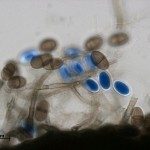Lien vers Pubmed [PMID] – 18701668
Lien DOI – 10.1128/JCM.01451-08
J Clin Microbiol 2008 Oct; 46(10): 3237-42
Debaryomyces hansenii is a hemiascomycetous yeast commonly found in natural substrates and in various types of cheese. Pichia guilliermondii is widely distributed in nature and is a common constituent of the normal human microflora. Both species have been described in human infections but are extremely difficult to differentiate phenotypically. Thus, frequent errors in identification occur. The 62 clinical and environmental isolates sent between 2000 and 2007 to the French National Reference Center for Mycoses and Antifungals as D. hansenii or P. guilliermondii were analyzed by using the carbon assimilation pattern, the presence of pseudohyphae, and sequencing of the ITS and D1/D2 regions of the rRNA gene. The objective of this study was to assess using nucleotide sequences whether phenotypic identification was accurate and whether phenotypic characteristics could be used to differentiate the two species when sequencing was not available. We found that 58% of the isolates were misidentified and belong to seven different species: P. guilliermondii, P. caribbica, P. jadinii, D. hansenii, Candida palmioleophila, C. haemulonii type II, and Clavispora lusitaniae. In conclusion, D. hansenii may not be as common a human pathogen as previously thought. Sequencing of either ITS or D1/D2 regions is a good tool for differentiating the species more frequently confused with D. hansenii, keeping in mind that reliable databases should be used.

